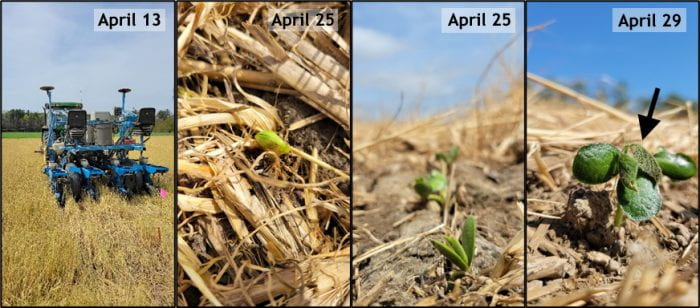Jarrod O. Miller, Extension Agronomist, jarrod@udel.edu, Cory Whaley, Sussex Co. Extension Ag Agent; whaley@udel.edu and Alyssa Koehler, Extension Field Crops Pathologist; akoehler@udel.edu
With support from the Delaware Soybean Board, we are performing a planting timing study for soybeans. Our first planting was done on April 13th while the second was done on April 26th, with a third to be done the second week of May.
The first planting emerged on April 24th – 25th (11-12 days) from planting (Figure 1) and as temperatures have stayed cooler, it appears the second planting is on a similar track. The April 13th planting saw faster emergence in portions of the field with less residue, where soil temperatures probably increased faster (Figure 1b and 1c). However, the warmer soil and earlier emergence may have led to freeze damage (Figure 1d) when Georgetown air temperatures dropped to the low 30s at night from April 28th– April 30th. Unifoliate leaves were damaged before they could fully unfold and have completed died on plants with the earliest emergence. Plants a few inches away that emerged a day or two later show minimal to no damage.
This project is mean to observe these unpredictable weather conditions and their effects on growth and yield, to help soybean growers decide their risk in future years. This type of freeze or frost damage was not observed in 2020 or 2021 but is still part of the early planting risk.

Figure 1. a) First planting on April 13th, b) emergence within residue, c) emergence on the same day with less residue, and d) freeze or frost damage to the unifoliate leaves 16 days after planting.
